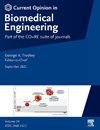3M engineering approaches to combat high-shear thrombosis: Integrating modeling, microfluidics, and mechanobiology
IF 4.2
3区 工程技术
Q2 ENGINEERING, BIOMEDICAL
引用次数: 0
Abstract
Arterial thrombosis remains a significant global health concern, with shear-induced platelet aggregation (SIPA) playing a crucial role. This review focuses on the integration of three key engineering approaches—Computational Modeling Microfluidics and Mechanobiology (3 M)—in understanding and combating high-shear thrombosis. We discuss the biomechanical mechanisms of SIPA, highlighting how platelet mechanoreceptors and von Willebrand factor interactions drive thrombosis under pathological flow conditions. Through computational fluid dynamics (CFD), key hemodynamic metrics including time-averaged wall shear stress, oscillatory shear index, and relative residence time have been developed to predict thrombosis risk. Microfluidic platforms, ranging from straight channels to stenotic geometries, provide insights into platelet behavior under various shear conditions while enabling rapid screening of antithrombotic therapies. The integration of these experimental approaches with CFD analysis offers powerful tools for predicting thrombosis risk and optimizing device designs, particularly in mechanical circulatory support devices (MCSDs). Recent advances in mechanobiology have revealed how mechanical forces trigger cellular responses through membrane damage and mechanosensitive channels, offering new therapeutic targets. This review underscores how the synergy between these 3 M engineering approaches advances our understanding of the complex interplay between hemodynamics and thrombosis, paving the way for improved antithrombotic therapies and medical device designs essential to optimizing MCSDs, such as left ventricular assist devices and extracorporeal membrane oxygenators.
对抗高剪切血栓形成的3M工程方法:集成建模、微流体和机械生物学
动脉血栓形成仍然是一个重要的全球健康问题,剪切诱导血小板聚集(SIPA)起着至关重要的作用。这篇综述的重点是整合三个关键的工程方法-计算建模微流体和力学生物学(3m) -在理解和对抗高剪切血栓形成。我们讨论了SIPA的生物力学机制,强调血小板机械受体和血管性血友病因子的相互作用如何在病理血流条件下驱动血栓形成。通过计算流体动力学(CFD),开发了包括时间平均壁面剪切应力、振荡剪切指数和相对停留时间在内的关键血流动力学指标来预测血栓形成风险。微流体平台,从直通道到狭窄的几何形状,提供了在各种剪切条件下血小板行为的见解,同时实现了抗血栓治疗的快速筛选。将这些实验方法与CFD分析相结合,为预测血栓形成风险和优化设备设计提供了强大的工具,特别是在机械循环支持设备(mcsd)中。机械生物学的最新进展揭示了机械力如何通过膜损伤和机械敏感通道触发细胞反应,提供了新的治疗靶点。这篇综述强调了这3种M工程方法之间的协同作用如何促进了我们对血流动力学和血栓形成之间复杂相互作用的理解,为改进抗血栓治疗和优化mcsd必不可少的医疗设备设计铺平了道路,如左心室辅助装置和体外膜氧合器。
本文章由计算机程序翻译,如有差异,请以英文原文为准。
求助全文
约1分钟内获得全文
求助全文
来源期刊

Current Opinion in Biomedical Engineering
Medicine-Medicine (miscellaneous)
CiteScore
8.60
自引率
2.60%
发文量
59
 求助内容:
求助内容: 应助结果提醒方式:
应助结果提醒方式:


